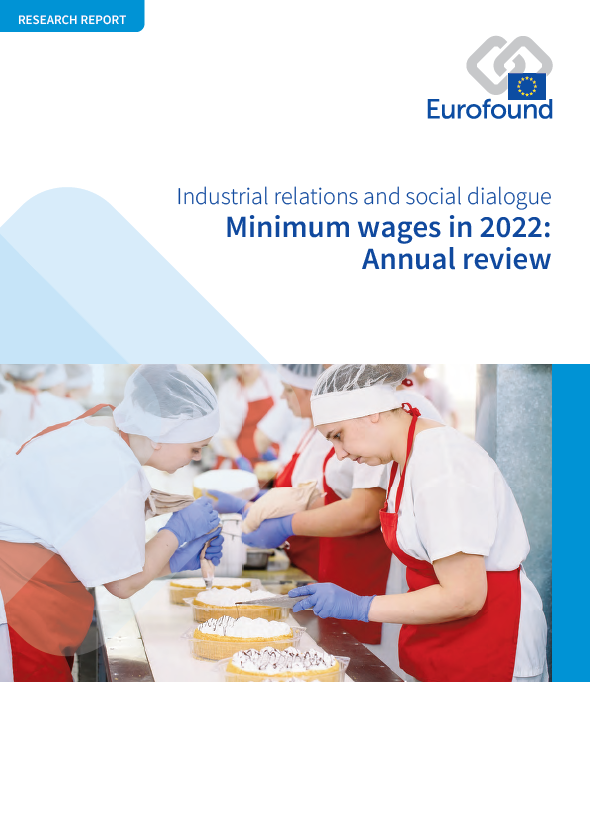
După o rundă precaută de stabilire a salariului minim pentru 2021, cotele nominale au crescut semnificativ pentru 2022, pe măsură ce consecințele negative ale pandemiei s-au atenuat, iar economiile și piețele muncii s-au redresat. În acest context, 20 din cele 21 de state membre ale UE cu salarii minime garantate și-au mărit cotele. O creștere substanțială a fost vizibilă în statele membre europene centrale și estice, comparativ cu statele membre aflate în etapa de preaderare, cea mai mare creștere înregistrându-se în Germania. Cu toate acestea, dacă se ia în considerare inflația, salariul minim a crescut în termeni reali doar în șase state membre.
Dacă tendința actuală a inflației continuă, în 2022, în orice țară, salariile minime vor crește într-o măsură foarte mică în termeni reali. Dacă problema nu este soluționată prin schimbări la nivel de politică în timpul anului, este posibil ca scăderea semnificativă a puterii de cumpărare să fie foarte răspândită în rândul persoanelor care câștigă salariul minim. În general, procesele de stabilire a salariului minim și legislația aferentă din UE au rămas neschimbate sau au fost adaptate doar într-o măsură mică pentru 2022.
Key findings
Deși salariile minime au crescut semnificativ între 1 ianuarie 2021 și 1 ianuarie 2022 în termeni nominali, când se ia în considerare creșterea inflației, impactul în viața reală nu se traduce într-o îmbunătățire a nivelului de trai. În aceeași perioadă, lucrătorii cu salarii minime din 15 din cele 21 de state membre care au un salariu minim garantat au observat o scădere a salariilor lor în termeni reali.
Dacă tendința actuală a inflației continuă, în 2022, în orice țară, salariile minime vor crește într-o măsură foarte mică în termeni reali, iar scăderea semnificativă a puterii de cumpărare va fi foarte răspândită în rândul persoanelor care câștigă salariul minim, dacă problema nu este soluționată în timpul anului prin majorări suplimentare sau prin alte măsuri de sprijin pentru angajații cu salarii mici. Țările cu mecanisme de indexare automate, precum Belgia, Franța și Luxemburg, au majorat salariile mai repede, în concordanță cu inflația, dar se pot introduce și majorări ad-hoc, după exemplul Greciei.
Propunerea de directivă a UE privind salariile minime adecvate determină deja câteva state membre să reorienteze dezbaterile cu privire la acest subiect și să se pregătească pentru schimbări în domenii precum definirea criteriilor pentru stabilirea salariilor sau creșterea salariilor în conformitate cu „valorile internaționale de referință” menționate în propunere. Germania, de exemplu, a decis să majoreze salariul minim, din octombrie 2022, la 12 EUR pe oră, respectiv aproximativ 60 % din salariile mediane.
Noile constatări arată că doar în Danemarca, Letonia și Norvegia au loc dezbateri cuprinzătoare între actorii naționali cu privire la promovarea negocierii colective și la creșterea acoperirii negocierilor colective. Stabilirea planurilor de acțiune pentru promovarea negocierii colective este un element important al noii directive a UE privind salariile minime adecvate și va fi o cerință principală pentru statele membre.
Salariile minime pot juca un rol esențial în reducerea inegalității salariale. De exemplu, constatările legate de Spania arată că impactul creșterii cu 22 % a salariului minim în 2019 a dus la cea mai mare reducere a inegalității salariale din cele 27 de state membre ale UE în același an. Este posibil ca acesta să fi fost rezultatul creșterii salariului minim, care a combătut nivelul ridicat de inegalitate salarială din Spania, o diferență care se accentuase în cursul anului anterior creșterii.
The report contains the following lists of tables and figures.
List of tables
Table 1: Gross statutory minimum wages, 21 EU Member States, 2021 and 2022 compared
Table 2: Change in monthly minimum wages (%) in collective agreements for 10 low-paid jobs, in nominal terms, 1 January 2020–1 January 2022
Table 3: Addressing low pay in collective bargaining in countries without statutory minimum wages
Table 4: Changes to minimum wage regulations in 2021 for 2022
Table 5: Setting of statutory minimum wages for 2022 in countries where the social partners did not reach an agreement
Table 6: Policy debates on changes to mechanisms for minimum wage setting
Table 7: From minimum to living wage policies – new developments in 2021 and early 2022
Table 8: Plans to increase minimum wages to bring them closer to median wages
Table 9: Changes in policies affecting net take-home pay
Table 10: Influence of proposed EU policy on national minimum wage setting
Table 11: Latest research on minimum wages in the EU, published in late 2020 and 2021
Table A1: Monthly equivalised basic pay rates from the largest collective agreements covering 10 low-paid jobs, January 2021 and January 2022 (national currencies)
Table A2: Monthly equivalised basic pay rates from the largest collective agreements covering 10 low-paid jobs, January 2022 (€)
Table A3: Change in monthly minimum wages in collective agreements, in real terms and in national currencies, between 1 January 2021 and 1 January 2022, for 10 low-paid jobs (%)
List of figures
Figure 1: Proportion of EU employees earning close to the minimum wage (%), by sociodemographic and employment characteristics, EU, 2018
Figure 2: Hourly minimum wages (€), 21 EU Member States, 2022
Figure 3: Year-on-year change in inflation rates (%), Member States, 2021 and 2022
Figure 4: Monthly evolution in inflation, by category, EU, January 2020–April 2022
Figure 5: Changes in minimum wages in real terms (%), 21 EU Member States, January 2021–January 2022
Figure 6: Minimum wages in nominal and real terms (€), Belgium, January 2020–May 2022
Figure 7: Collectively agreed average and median monthly wages (€) in 10 low-paid jobs, January 2022
Figure 8: Change in average monthly minimum wages (%) set in collective agreements for 10 low-paid jobs, in nominal and real terms, 1 January 2020–1 January 2022
Figure 9: Minimum wage setting for 2022 and the role of the social partners
Figure 10: Evolution of average wages by wage quintile, Spain, 2009–2019
Figure 11: Relative change in average wages (%) by wage decile, Spain, 2018 and 2019
Figure 12: Relative change in wage inequality (%), EU Member States, 2018 and 2019
Figure 13: Relative change in average wages (%) by employees’ sociodemographic and employment characteristics, Spain, 2018 and 2019
Figure 14: Relative change in average wages by wage decile, and change in wage inequality, Spain, 2019 (%)
Figure A1: Changes in minimum wages in real terms, selected EU Member States by group, January 2020 to January 2022
- Number of pages
-
76
- Reference nº
-
EF22040EN
- ISBN
-
978-92-897-2266-7
- Catalogue nº
-
TJ-AS-22-001-EN-N
- DOI
-
10.2806/754979
- Permalink
Listen to our Eurofound Talks podcast on minimum wages
In episode 7 of our Eurofound Talks podcast series, we speak with Senior Research Manager Christine Aumayr-Pintar on the importance of minimum wages in the EU, different processes in place, the latest EU developments in ensuring adequate minimum wages, and the growing issue of inflation for low-wage earners.
Cite this publication
Eurofound (2022), Minimum wages in 2022: Annual review, Minimum wages in the EU series, Publications Office of the European Union, Luxembourg
